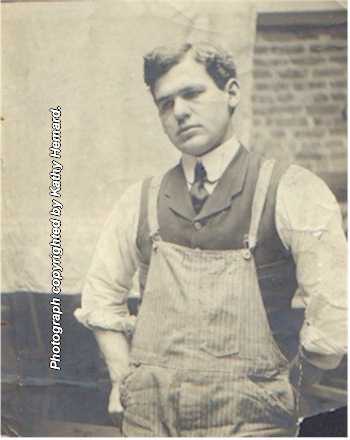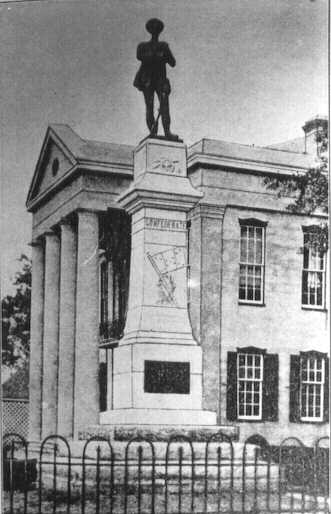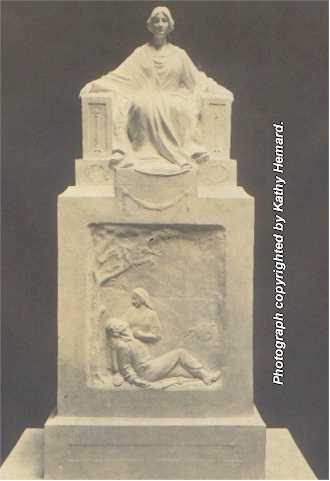|
Frederick
C. Hibbard: Raymond Confederate Monument by Rebecca Blackwell Drake
On April 28, 1908, a journalist for the Clarion-Ledger attended the dedication of the Confederate Monument in Raymond and reported, "A red letter day and one of the greatest days in the history of Raymond." A red-letter day it was. Over two thousand people gathered on the courthouse grounds, anxious to witness the unveiling of the long-awaited Hinds County Confederate Monument, sponsored by the Nathan Bedford Forrest Chapter of the United Daughters of the Confederacy. As the Jackson Band played a rousing rendition of Dixie, seven little girls pulled the cord to unveil the monument. The crowd was overcome with emotion as they viewed the twenty-seven foot statue placed in memory of the Confederate soldiers of Hinds County. Hinds County was not the only county to erect a Confederate monument. As early as 1906, the Mississippi Legislature appropriated $50,000 for the erection of Confederate monuments statewide. Spearheaded by the U.D.C., the plan was for every county in Mississippi to have a monument of its choice. "The guiding hand behind the monument was the N. B. Forrest Chapter of the UDC." States Robert and Marion Bassett, volunteer workers for Save Outdoor Sculpture. "Members of the U.D. C. conceived the idea and approached the Hinds County Board of Supervisors, asking that they lend support to this project. The Board of Supervisors approved and allocated $4,000 for the monument." As to the actual construction of the monument, Bassett commented, "One lady told me that at that time (1908) a great many monuments and statues were being erected. Consequently, there were a great number of 'statue salesmen' who represented firms with a catalog of statues and listed prices. The purchaser merely leafed through the catalog, determined what statue was desired and signed an order blank. Presumably this applied to salesmen who sold granite shafts as well as bronze soldiers." Whether or not the Raymond monument was ordered by catalogue remains unknown.
The women of Raymond who chose the Confederate Monument did so with only the best of materials and workmanship in mind. The pink and gray stonework came from the quarry of Frank Teich in Llano, Texas. Inscriptions on the granite shaft reflect the post war sentiments of the women of Raymond. The front inscription reads, "Erected by the people of Hinds County, in grateful memory of their men who in 1861-1865 gave or offered to give their lives in defense of constitutional government and to the heroic women whose devotion to our cause in its darkest hour sustained the strong and strengthened the weak." Highlighted on the front of the monument is a bronze plaque signed by Frederick C. Hibbard, master sculptor from Chicago. The plaque pays tribute to the women of Hinds County who nursed the wounded and dying soldiers. Depicted on the plaque is a wounded soldier resting on the ground under a tree. A woman, who is giving him a drink from a canteen, supports the soldier. The Confederate Monument in Raymond is listed in the Smithsonian Inventory of American Paintings and Sculptures. The inventory credits Frank Teich for the base stonework and Frederick Hibbard for the poignant bronze plaque. The unknown is whether or not Hibbard designed the bronze soldier or if it was a product of the American Bronze Company.
By the end of World War I, Frederick C. Hibbard had designed and produced three of the most famous outdoor sculptures in the United States: The Confederate Monument on the battlefield at Shiloh; The Eagle on the portico of the Illinois Monument, Vicksburg; and the equestrian statue of General Ulysses S. Grant in the Vicksburg national Military Park. To discover the art work of Frederick Hibbard and the stonework of Frank Teich on the Confederate Monument in Raymond is equivalent to having found a long lost Picasso. Link to Other Hibbard Articles: Part II *Historic sources: Smithsonian Institute; 1992 Save Outdoor Sculpture report by Robert and Marion Bassett; and personal notes from Mrs. Kathy Hemard, granddaughter of Frederick C. Hibbard. *Editor's note: Frederick Hibbard was married to Gladys Hibbard and they had five children, three sons and two daughters. After the death of Gladys, he married Elisabeth Haseltine, a sculptor renowned for her animal studies. The information and photographs used in the series on Hibbard are courtesy of Mrs. Kathy Hemard, the granddaughter of Hibbard, who is in possession of much his memorabilia, including photographs of his works. © 2002-2005, all rights reserved |


